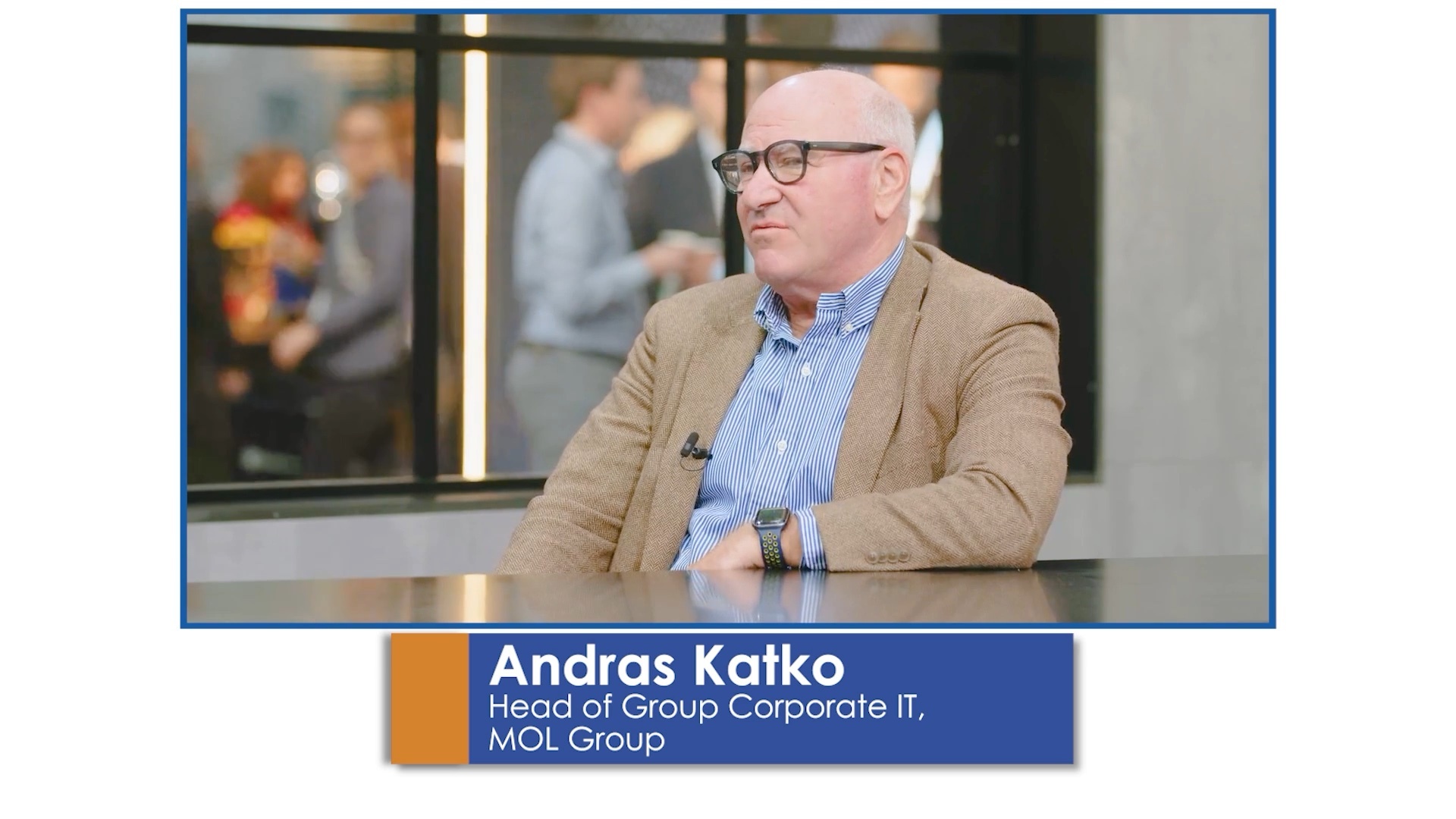
MOL Group adopts Celonis Process Sphere for end-to-end process visibility
When the COVID-19 pandemic hit, MOL Group needed to adapt quickly. The international oil and gas company needed full transparency into their day-to-day operations so they could monitor and shift resources in real time. They turned to the Celonis Execution Management System (EMS).
“With the old-fashioned way, we were not able to react quickly enough,” said András Katkó, Head of Group IT Back Office at MOL Group.
At Celosphere 2022, Katkó sat down with Acceleration Economy Network analyst Tom Smith to talk about MOL's business, how process mining allowed the company to rapidly adapt to the challenges of the COVID pandemic and the Celonis use cases they're deploying today. In particular, the company is an early adopter of Celonis Process Sphere™, a new capability of Celonis EMS, which was announced at Celosphere is built on a new type of process mining technology, called object-centric process mining (OCPM).
“Celonis Process Sphere has proven valuable to our organization as it shows an entire process at a glance, while also presenting the handshakes that go between different processes,” said Katkó in a press release.

The following is a transcript of the interview, edited for readability.
MOL Group + Celonis
Tom Smith: Can you start out telling us a little bit about who MOL is, what the company does, as well as your role please?
Andras Katko: All right, so MOL is a Central European company, oil and gas. We have a presence in 25 countries. We are in business for more than 80 years and we have upstream, downstream, retail as well, so everything that you can imagine in a general oil and gas company.
I'm working for IT. I'm actually heading all the technology part. It's called IT Group Back Office. I have the CTO, the CDO, as well as the core systems are under my umbrella so the CTO, technology, everything, the group-level technology, data, analytics, all the data, and we are try to monetize the data, and that's how I came to the picture with Celonis. We have the core systems, which is ERP, Salesforce, Robotiqa, that type of things in my area.
Tom Smith: Can you tell us then how it is you came to work with Celonis and where Celonis fits into all of that, all of those responsibilities that you have?
Andras Katko: In 2018, I saw Celonis in action at an SAP conference, so it was pretty impressive. We did a PoC first and it was so good that in three days we were able to really bring all the purchase-to-pay processes in a PoC, so a proof of concept. We said that we have to continue, and so we created, first purchase-to-pay, plus at that time we had just rolled out maintenance for the whole company. We renovated the original ERP system, so it was a good opportunity to actually measure back how successful we were adapting the new processes that we figured out.
It was a very quick feedback to the field people, whether they do your job right or not, and we continued with order-to-cash a year later. Then, we rolled it out for IT service management and this is how we started. It was immediately, it was very successful. We’ve seen improvement on data quality as well as on processing efficiency as well.
Adapting to COVID-19 meant having full process transparency
Tom Smith: Efficiency, okay, and just in terms of the time that those activities were completed. I understand that as you progressed, as we got into 2020, your company had a lot of... felt a lot of impact from COVID and that Celonis software helped you through that. Can you tell the viewers more about that?
Andras Katko: Okay, in simple terms, the home office, on one hand, the breakdown of supply chains was on the other hand, definitely gave us a lot of challenges.
With the old-fashioned way, we were not able to react quickly enough, and so with the data that we had in Celonis, we were able to predict how many people available, whether it was, who is not sick, who is actually does the work. Plus, because of the supply chain plus economic situation, we canceled a few projects, so we had to reshuffle everything and it was always high peaks and suddenly we were not able to do the job properly.
Also: How Celonis supports MOL in reinventing itself during COVID-19 crisis
Suddenly with Celonis, we were able to forecast much better and actually plan and measure back whether that was successful. The turnaround of the decision was reduced from weeks down to days or even sometimes hours.
Tom Smith: Are the learnings from that experience and the benefits, are those still being felt today? Are there…has that impacted your business processes?
Andras Katko: It's all for the operationalized in terms of it's became part of the day-to-day logistics of procurements is actually part of now.
Process Sphere + Workforce Productivity + Intelligence API
Tom Smith: Celonis is making some pretty significant product announcements here at Celosphere. One of them is Process Sphere™, which I know you're familiar with, Business Miner™. They've also got some very significant relationships that around sustainability. Curious from your perspective, what's the potential impact to your business of, let's say, Process Sphere and Business Miner?
Andras Katko: Process Sphere has more importance for us. I mentioned maintenance. We were one of the few companies in Celonis who has the multi-event log actually used. We've created a very complex system.
The Process Sphere will give us an amazing ease to operate and get much better results. Actually, we can delegate more analysis to the business rather than IT people because currently the system is so complex that majority of the reporting, the preparation the reporting must require certain type of skill set that we believe that's process we will bridge and we will have a better…
Tom Smith: Democratizing the technology to a greater extent.
Andras Katko: ... process. The Business Miner I believe that this moment is not as relevant because wherever we use it, the users are pretty advanced. We have to see whether when they expand the rich for the business mining, we might have a use.
However, there was a few other product announcements, task mining. We already did PoC on task mining, and I think we will expand based on what we heard to other parts of the business.
Also: Celonis Workforce Productivity enables end-to-end process, employee experience improvement
Tom Smith: What specifically about the new task mining functions have the most utility to you?
Andras Katko: I mean, look, it's one hand the efficiency. The other one is now that the question is not how to replace someone, but actually we don't have people now to do their job because it's, some of the activities are so boring that people are not coming to do certain very repetitive things. Obviously, we need to figure out where the time wasted so we can see in the process mining that some process stopped for hours or days.
Now with task mining, we can expand and we can actually look at into, what is the root cause of those things. Definitely that will be something that we are looking for, efficiency, replacement of humans on jobs which is not value added, but it's still necessary.
Tom Smith: That has to happen. Yeah.
Andras Katko: Yeah, and one more thing that we really like is the Intelligence API, which might give us a chance to combine Power BI capabilities and give more rich of Celonis analysis to the public who has no licenses, but still we are able to share some of the KPIs, some of the analysis. It will help not only executive management view, but operational-level people will get more access to analysis and they can act upon that.
Creating a Celonis CoE at MOL Group
Tom Smith: Okay. Final question for you. Obviously, lots of big Celonis customers here, lots of sessions about centers of excellence (CoE) and how to operationalize the use of this technology. Can you speak a little bit to what's the opportunity for you as a customer to either network or learn from peers? How is this environment for that purpose?
Andras Katko: It's definitely we reached the point that we need a much stronger COE, and so to me it's really a good opportunity to learn how, let's say, Pfizer and Bayer did a COE, how they did it, but always the question, how the COE relates to a corporate culture? I can see that there is a centralized/decentralized upwards, downwards, and all of them could be inefficient in a certain culture. Meanwhile, some of them would be pretty well-rounded in a corporate culture, so we have to figure out which is the best setup for those.
More from Celosphere 2022
Celosphere 2022: Everything you need to know news, product, process mining best practices
Celosphere 2022: Celonis brings perspective to process mining
A Closer Look: Celonis' acquisition of Sailfin, Intelligent Accounts Receivable apps
Celonis announces next-generation MRI process mining technology with Process Sphere™
Celosphere 2022: You’re going to see groundbreaking progress on process mining technology
Editor’s note: This video was originally published on Acceleration Economy, How MOL Group Benefits From Celonis Process Mining Products and Apps.



